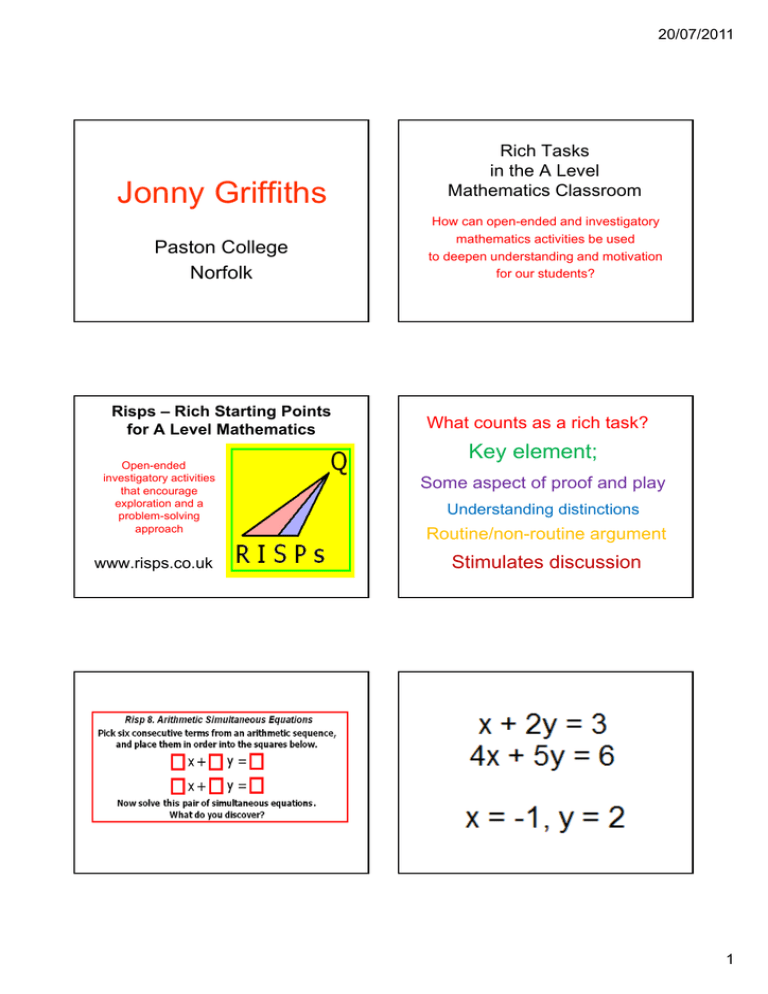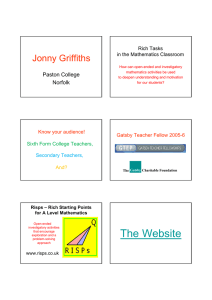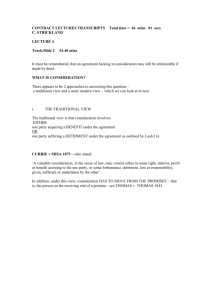Jonny Griffiths Paston College Rich Tasks in the A Level
advertisement

20/07/2011 Jonny Griffiths Paston College Norfolk Risps – Rich Starting Points for A Level Mathematics Open-ended investigatory activities that encourage exploration and a problem-solving approach www.risps.co.uk Rich Tasks in the A Level Mathematics Classroom How can open-ended and investigatory mathematics activities be used to deepen understanding and motivation for our students? What counts as a rich task? Key element; Some aspect of proof and play Understanding distinctions Routine/non-routine argument Stimulates discussion 1 20/07/2011 Conjecture; if the six coefficients are consecutive terms from an arithmetic progression, then the solution will be x = -1, y = 2. Converse; if the solution to a linear simultaneous equation in x and y is x = -1, y = 2, then the six coefficients are consecutive terms from an arithmetic progression. True? The point (-1,2) is always on ax + (a+d)y = a+2d Counter-example If (-1,2) is on ax + by = c, then a, b and c are in arithmetic progression 2 20/07/2011 Mini-theorem; the solution to a linear simultaneous equation in x and y is x = -1, y = 2 iff the top three coefficients are consecutive terms from an arithmetic progression, as are the bottom three. Fibonnacci? Geometric? Three variables? Use of computing power to reduce drudgery Examples are self-generated There is an element of ‘magic’ here A rich task involves generalising, conjecture and proving a mini-theorem Good mathematical processes are leading somewhere; there is a goal Extensions suggest themselves Easy teacher checking Range of abilities in your classroom? A rich task differentiates Non-threatening “Start with any quadratic at all!” Puzzle element – “collect the set!” Easy for the teacher Differentiated No guarantee everything is possible Encourages discussion Overall description: factors of 60 Property 1: multiples of 3 Property 2: multiples of 5 Property 3: multiples of 6 Extendable Understand distinctions 3 20/07/2011 Overall description: all lines y = mx + c Property 1: Line goes through (3, 0) Property 2: Line goes through (2, 4) Property 3: Lines are perpendicular Arrange some or all of these tiles to define a sequence in as many different ways as you can. Overall description: all binary operations on the set of real numbers excluding 0 Property 1: commutative Property 2: associative Property 3: closed Un = 1, 1, 1, 1, 1… Un = -n, -1, -2, -3, -4… Un = 1/n , 1, 1/2, 1/3, 1/4… Un = nn , 1, 4, 27, 256… Un = (-1)n , -1, 1, -1, 1… Un = (-n)n , -1, 4, -27, 256… Un = (-1)n /n, -1, 1/2, -1/3, ¼… What different behaviours do these sequences exhibit? Un = (n-1)/n , 0, 1/2, 2/3, ¾… 4 20/07/2011 Type the equation y = ax² + bx + c into your graphing package. Now mix up a, b and c to give six parabolas, one for each order. Now try varying a, b, and c using the Constant Controller. Do these six parabolas have anything in common? Can you find a, b and c so that: 1. all the lines of symmetry are to the left of the y-axis? Need –a/2b -b/2c -c/2a to all be positive… 2. all the lines of symmetry are to the right of the y-axis? 3. all six parabolas have two solutions for y = 0? 5 20/07/2011 Need 2 b > 4ac c2 > 4ba a2 > 4bc Choose a –ve, b –ve c large and +ve 90-minute lesson Theory then Practice 45 mins theory, 45 mins practice Explore then Theory then Practice 30 mins exploration 30 mins theory 30 mins practice Student response Lesson 1 Theory then Practice OR… Lesson 2 Explore then Theory then Practice Lesson 1 Theory then Practice Bread and butter Lesson 2 Explore then Theory then Practice Jam Sandwich Bread, butter and jam. Risps will solve all your problems! Lesson Two was scary. We wanted to be told what to do. Your students will love your lessons, And they will all get brilliant grades… maybe… 6 20/07/2011 Potential Risp Problems Unexpected outcomes can throw the teacher (and can confuse the student ) How much curiosity is there at the start of the activity? The risp turns out to be more difficult than expected… The teacher feels insecure Much more skill and energy is required from the risps teacher Educationalists want us to teach in open-ended ways, to really make our students think hard mathematically… So why are our exam questions so closed? Risps are what students remember What was the first investigation you took part in? A good Theory-Practice lesson is better than a bad Explore-Theory-Practice lesson Risps are risky! But… Risps are what real mathematicians do Conjecturing, Generalising, Modelling, Discussing, Making mistakes, Problem-solving, Refining, Proving, Waiting… Where do risps go right? When consolidation is playful and active and involves discussion When the theory is constructed together once students see the need for it When I set a task that is so engrossing that my students forget I am in the room 7 20/07/2011 So we should never lose faith when it comes to risps… Why did I become a maths teacher in the first place? 8 MEI Conference, University of Keele, 2011 www.risps.co.uk Rich Starting Points – for A Level Pure Mathematics Risp 1: Triangle Number Differences When is the difference between two triangle numbers prime? Risp 10: Venn Diagrams Risp 2: Sequence Tiles Arrange some or all of these tiles to define a sequence in as many different ways as you can. These sequences behave in different ways. How many different behaviours can you find? Risp 12: Two Repeats In an idle moment, Luke picked two numbers x and y with 0 < x < y < 1. Wondering how to combine these simply, he wrote down the numbers x + y, xy, x/y, y/x, x - y, y - x He realized to his surprise that he had written the same number down twice. To his further surprise, he noticed that he had written a second number down twice. What were his starting numbers? Jonny Griffiths, Paston College jonny.griffiths@paston.ac.uk www.jonny-griffiths.net Sister Site: www.making-statistics-vital.co.uk



